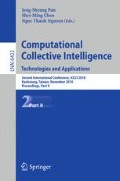Abstract
A novel feature based watermark synchronization scheme is presented in this paper. The feature points are first extracted from the image and the idea of locally most stable feature points (LMSP) is proposed to generate some non-overlapped circular areas. The local regions are geometrically invariant so that they can be directly used for efficient watermark embedding and extraction. Simulation results have demonstrated the effectiveness of the proposed scheme.
Access this chapter
Tax calculation will be finalised at checkout
Purchases are for personal use only
Preview
Unable to display preview. Download preview PDF.
References
O’Ruanaidh, J., Pun, T.: Rotation, scale and translation invariant digital image watermarking. Signal Process. 66(3), 303–317 (1998)
Lin, C., Wu, M., Bloom, J., Cox, I., Miller, M., Lui, Y.: Rotation, scale, and translation resilient watermarking of images. IEEE Trans. Image Process. 10(5), 767–782 (2001)
Zheng, D., Zhao, J., El-Saddik, A.: RST-invariant digital image watermarking based on log-polar mapping and phase correlation. IEEE Trans. Circuits Syst. Video Technol. 13(8), 753–765 (2003)
Kim, H., Lee, H.: Invariant image watermark using Zernike moments. IEEE Trans. Circuits Syst. Video Technol. 13(8), 766–775 (2003)
Xin, Y., Liao, S., Pawlak, M.: Circularly orthogonal moments for geometrically robust image watermarking. Pattern Recognit. 40(12), 3740–3752 (2007)
Pereira, S., Pun, T.: Robust template matching for affine resistant image watermarks. IEEE Trans. Image Process. 9(6), 1123–1129 (2000)
Kutter, M., Bhattacharjee, S., Ebrahimi, T.: Towards second generation watermarking schemes. In: Proc. IEEE Int. Conf. Image Process., Kobe, Japan., vol. 1, pp. 320–323 (1999)
Bas, P., Chassery, J., Macq, B.: Geometrically invariant watermarking using feature points. IEEE Trans. Image Process. 11(9), 1014–1028 (2002)
Qi, X., Qi, J.: A robust content-based digital image watermarking scheme. Signal Process. 87(6), 1264–1280 (2007)
Tang, C., Hang, H.: A feature-based robust digital image watermarking scheme. IEEE Trans. Signal Process. 51(4), 950–959 (2003)
Seo, J., Yoo, C.: Localized image watermarking based on feature points of scale-space representation. Pattern Recognit. 37(7), 1365–1375 (2004)
Seo, J., Yoo, C.: Image watermarking based on invariant regions of scale-space representation. IEEE Trans. Signal Process. 54(4), 1537–1549 (2004)
Wang, X., Wu, J., Niu, P.: A new digital image watermarking algorithm resilient to desynchronization attacks. IEEE Trans. Inf. Forensics Security 2(4), 655–663 (2007)
Lee, H., Kim, H., Lee, H.: Robust image watermarking using local invariant features. Opt. Eng. 45(3), 037002(1–11) (2006)
Harris, C., Stephens, M.: A combined corner and edge detector. In: Proceedings of 4th Alvey Vision Conference, pp. 147–151 (1988)
Alghoniemy, M., Tewfik, A.: Geometric invariance in image watermarking. IEEE Trans. Image Process. 13(2), 145–153 (2004)
Mikolajczyk, K., Schmid, C.: Scale and affine invariant interest point detectors. Int. J. Comput. Vis. 60(1), 63–86 (2004)
Lowe, D.: Distinctive image features from scale-invariant keypoints. Int. J. Comput. Vis. 60(2), 91–110 (2004)
Author information
Authors and Affiliations
Editor information
Editors and Affiliations
Rights and permissions
Copyright information
© 2010 Springer-Verlag Berlin Heidelberg
About this paper
Cite this paper
Qian, J., Li, L., Lu, Z. (2010). Watermark Synchronization Based on Locally Most Stable Feature Points. In: Pan, JS., Chen, SM., Nguyen, N.T. (eds) Computational Collective Intelligence. Technologies and Applications. ICCCI 2010. Lecture Notes in Computer Science(), vol 6422. Springer, Berlin, Heidelberg. https://doi.org/10.1007/978-3-642-16732-4_33
Download citation
DOI: https://doi.org/10.1007/978-3-642-16732-4_33
Publisher Name: Springer, Berlin, Heidelberg
Print ISBN: 978-3-642-16731-7
Online ISBN: 978-3-642-16732-4
eBook Packages: Computer ScienceComputer Science (R0)

